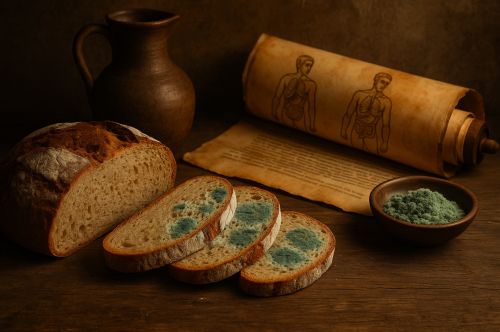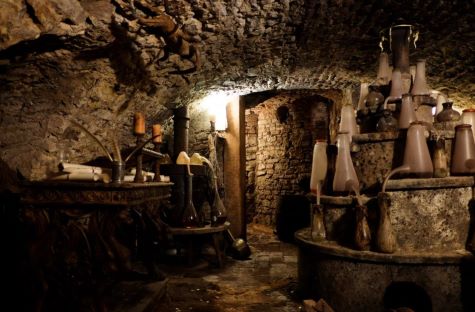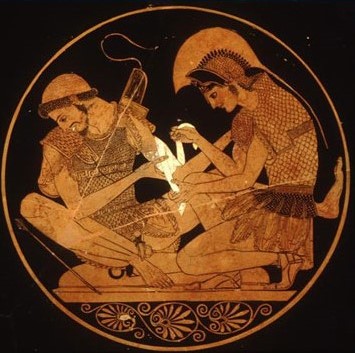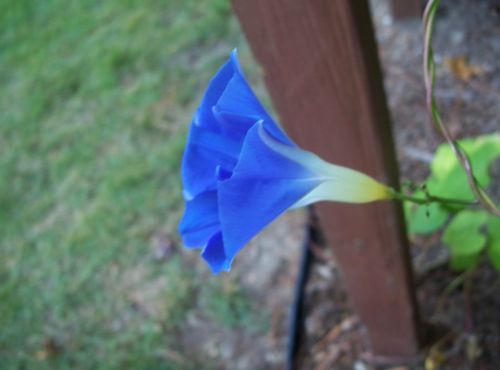

When Fleming looked upon his Petri dish in 1928 and saw the death of bacteria near a patch of Penicillium, he was not standing at the beginning of a story but at its continuation.

By Matthew A. McIntosh
Public Historian
Brewminate
Healing Before Science
Long before Alexander Fleming observed the accidental miracle of penicillin in 1928, ancient civilizations had already discovered that mold could heal. Their discoveries were not made in sterile laboratories, nor written into scientific journals, but emerged instead from the soil of lived experience, practical trial, and cultural memory. What later generations would call “antibiotics” were in antiquity matters of instinct, ritual, and survival.
The Egyptians, Chinese, Greeks, and Maya each developed their own ways of incorporating mold into healing practices. They could not have known of bacterial structures, cellular mechanisms, or chemical compounds, but they grasped the simple truth that something invisible in the rot of bread or the dampness of earth could save lives. These practices, however, were neither uniform nor without danger. The boundary between remedy and poison was razor-thin, and what one healer praised as curative another condemned as corruptive.
To understand these practices requires more than cataloguing medical recipes; it requires examining how ancient societies conceptualized health itself. For them, medicine was not isolated from religion, politics, or cosmology. The mold that healed was also the mold that threatened order, just as disease was often viewed as a disruption of balance rather than a mechanical infection.
Egypt and the Alchemy of Rot

Egyptian medical papyri, such as the Ebers Papyrus, reveal remedies that made deliberate use of moldy bread applied to wounds.1 Far from an act of desperation, this was a practice rooted in a belief that divine balance could be restored through substances both earthly and sacred. Egyptian medicine existed in a continuum of ritual and pragmatism: mold was not just a material but part of an alchemical transformation, a visible decay harnessed to counter invisible disorder.
The Nile Valley’s humid climate accelerated the growth of molds on stored grain and bread, making their presence ubiquitous. Healers may have noticed that wounds treated with these substances fared better, that infections subsided when mold was present. Yet this empirical knowledge never severed itself from its ritual context. The act of applying mold was simultaneously a medical and spiritual gesture, an invocation of cosmic healing.
Egypt thus illustrates how early societies blurred the line between observation and metaphysics. Their practical insights were entangled with sacred worldviews, but those entanglements did not invalidate the therapeutic effect. Indeed, it was precisely this interweaving that allowed mold to become medicine rather than refuse.
China and the Pharmacopeia of Nature

In classical Chinese medicine, the search for balance between yin and yang and the flow of qi provided the intellectual framework for medical practice. Texts such as the Shennong Bencao Jing (Divine Farmer’s Classic of Materia Medica) refer obliquely to substances that align with what modern scholars identify as mold-based remedies.2 These were not identified chemically but understood in terms of their effect on harmony within the body.
What distinguished Chinese practice was the integration of mold-based therapies into a larger system of dietetics and pharmacology. Rather than isolated cures, molds and fermented substances were part of a broader approach to balance. Here again, empirical results were absorbed into a cosmological vision. Healing with mold was not an accidental discovery but a cultivated wisdom, passed down through generations, adjusted by scholars and practitioners who saw medicine as inseparable from philosophy.
Greece and the Rationalization of Healing

Greek medicine, particularly under Hippocratic influence, sought to rationalize healing by framing illness as a natural, not divine, phenomenon. Within this framework, mold-based remedies occupied a transitional space. Accounts exist of Greek physicians using moldy bread for wound treatment, echoing Egyptian practices but now subject to the Hippocratic emphasis on observation.3
For the Greeks, the presence of mold was not sacred but natural, a visible marker of decay that paradoxically could restore health. By placing such practices within their humoral theory, they reinterpreted mold as part of the interplay of hot, cold, wet, and dry. This reframing allowed Greek medicine to step closer to what we might call proto-science, while still lacking the microbiological understanding that would later define modern medicine.
Greece reveals how ancient medical traditions could simultaneously preserve old practices and reinterpret them under new intellectual orders. What was divine in Egypt became natural in Greece, but in both contexts mold retained its place as a healer.
The Maya and the Sacred Landscape of Healing

In the Americas, the Maya embedded healing in a cosmology that linked the body to the landscape. Archaeological and ethnobotanical evidence suggests they employed mold and fermented substances in wound care and possibly internal medicine.4 Like their Old World counterparts, the Maya did not view mold as separate from their sacred worldview. Healing was an act of alignment with cosmic forces, and mold’s liminality (between life and decay) carried symbolic power.
The Maya remind us that the ancient use of molds was not confined to one region or culture. Across continents, societies independently discovered the therapeutic potential of decay. What varied was the conceptual frame: Egyptian divine order, Chinese harmony, Greek naturalism, and Maya cosmology. All converged on the same empirical reality, that mold could heal.
Conclusion: Echoes of Ancient Wisdom
When Fleming looked upon his Petri dish and saw the death of bacteria near a patch of Penicillium, he was not standing at the beginning of a story but at its continuation. The ancients had already recognized that mold could heal, though they interpreted it through the prisms of their own worldviews. Their discoveries did not amount to modern science, but they reveal how knowledge grows from layered traditions, empirical observations, and cultural meanings.
The history of mold as medicine is therefore not just a curiosity but a testament to the persistence of human ingenuity. It shows us that even in the absence of microbiology, ancient peoples could grasp truths that modern science would later confirm. More than that, it reminds us that healing has always been an act of imagination as well as observation, one that transforms the refuse of decay into the substance of life.
Appendix
Footnotes
- Ebers Papyrus, trans. Paul Ghalioungui, The Ebers Papyrus: A New English Translation (Cairo: Academy of Scientific Research and Technology, 1987).
- Li Shizhen, Compendium of Materia Medica (Bencao Gangmu), 16th century, trans. Shizhen Li.
- Hippocrates, On Ancient Medicine, trans. Mark J. Schiefsky (Leiden: Brill, 2005).
- Michael D. Coe and Stephen Houston, The Maya (London: Thames & Hudson, 2022).
Bibliography
- Coe, Michael D., and Stephen Houston. The Maya. London: Thames & Hudson, 2022.
- Ebers Papyrus. Translated by Paul Ghalioungui. The Ebers Papyrus: A New English Translation. Cairo: Academy of Scientific Research and Technology, 1987.
- Hippocrates. On Ancient Medicine. Translated by Mark J. Schiefsky. Leiden: Brill, 2005.
- Li, Shizhen. Compendium of Materia Medica (Bencao Gangmu). 16th century.
Originally published by Brewminate, 09.10.2025, under the terms of a Creative Commons Attribution-NonCommercial-NoDerivatives 4.0 International license.


